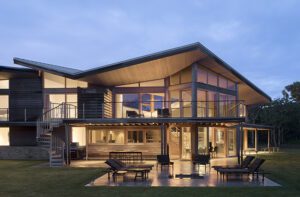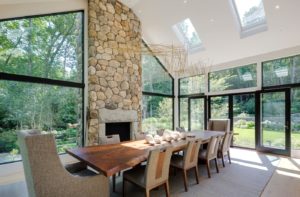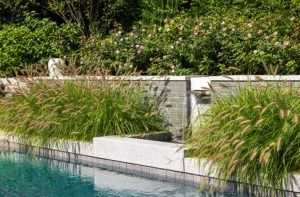Glass Action: Carrie Gustafson, Cambridge Glass Artist
December 23, 2013
Text by Louis Postel
Carrie Gustafson’s luminous pieces provoke an irresistible urge to take them in hand, hold them to the light, and explore the tension between rough and smooth, earthy and ethereal.
The open mouth of the oven burns at 2,200 degrees. Men in goggles move back and forth, holding rods stuck with red-hot glass. Their syncopated rhythm suggests that some ancient rite is at hand. Carrie Gustafson stands off to the side, observing. She doesn’t blow glass, but she is a glass artist with a studio in this former factory in Cambridge, Massachusetts. In fact, she is building a reputation as one of the leading studio-glass makers in New England. She goes to work after the glass from the “hot shop” has cooled, not before.
Her tools are for making images, patterns, and silhouettes: X-Acto knives, adhesive stencils, and cutting, sanding, and sandblasting equipment. Unlike the fast teamwork required around the furnaces, cool work like Gustafson’s involves a long and solitary process.
“It can take ten years just to develop your own glazes, your own symbols and vocabulary,” says Gustafson, now in her sixteenth year as a glass artist. “I find that as I get older and more stable, I am feeling more open. I feel we arrive at a time for letting more light in our lives—and glass is the perfect medium to express that arrival, the way it holds light and reflects it.”
Gustafson creates objects that are often small in scale but with big color blocking, like a Marimekko fabric. Many are in the form of household objects—vessels and vases, dishes and bottles. “I am not sure why that is,” says Gustafson. “I just find myself drawn to household things.”
An African currency bracelet inspired a seven-inch-by-nine-inch piece that sits on Gustafson’s studio shelf. It holds your attention like a Grecian urn or a Ming vase: a timeless tension between ethereal and earthy, rough and smooth, between the volcanic lava that gave it birth and the purely translucent. Hold it up to the light and it’s a marvel how the work’s patterns and silhouettes shift with the slightest tilt.
Natural light and shade reveal the most beautiful primary forms in design: the play of cylinders, pyramids, spheres, and cones, as Corbusier famously observed. It is something every designer and architect knows instinctually. Gustafson’s glowing objects put this play of forms in your own two hands. Later in the spring, Gustafson will sell these African-inspired pieces for about $10,000 apiece at the Smithsonian’s Craft Show, or at the Lori Warner Gallery in Chester, Connecticut.
Gustafson was not always so good at animating glass—or anything else, at least in her opinion. As the granddaughter of Paul Gustavson, she grew up surrounded by the drawings of one of the pioneers of action comics: the Arrow, the Jester, the Spider, and other classics. “I kept trying to draw the way he did, but it was very frustrating,” she says. “I couldn’t get those animated gestures—only today do I feel I am finally getting it with glass.”
Equally challenging was Victor Lara, Gustafson’s legendary drawing teacher at the Rhode Island School of Design, from which she graduated in 1994. “I would work incredibly hard on some drawing and he would stand behind me for a while and then he’d just flip the sheet over to a blank one. It was exasperating, but I stuck it out.”
If there is one drawing lesson Gustafson will never forget, it’s the importance of paying attention to what’s happening outside the line, as well as what’s inside it. Or, translated to 3-D, what does the silhouette of her glass bowl do to the space around it?
Leading New England firms such as Flavin Architects and Meyer & Meyer have commissioned Gustafson for custom pieces, mainly for lighting. For Flavin it was ten-inch glass globes inserted within twenty-six-inch globes—sixteen, all suspended at different heights in a dining room. Although the effect was gorgeous, Gustafson still prefers natural light. “Sandblasting gives depth, and a light bulb takes it away,” she says.
One could say the same about photos of her work. They’re better than nothing, but to truly appreciate what Gustafson does, you would have to hold her pieces up to natural light and experience them in all their glorious animation. •
Editor’s Note: To see more of Carrie Gustafson’s work, visit carriegustafson.com
Share
![NEH-Logo_Black[1] NEH-Logo_Black[1]](https://www.nehomemag.com/wp-content/uploads/2022/08/NEH-Logo_Black1-300x162.jpg)
















You must be logged in to post a comment.